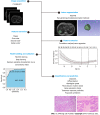Role of radiomics in the diagnosis and treatment of gastrointestinal cancer
- PMID: 36405385
- PMCID: PMC9669820
- DOI: 10.3748/wjg.v28.i42.6002
Role of radiomics in the diagnosis and treatment of gastrointestinal cancer
Abstract
Gastrointestinal cancer (GIC) has high morbidity and mortality as one of the main causes of cancer death. Preoperative risk stratification is critical to guide patient management, but traditional imaging studies have difficulty predicting its biological behavior. The emerging field of radiomics allows the conversion of potential pathophysiological information in existing medical images that cannot be visually recognized into high-dimensional quantitative image features. Tumor lesion characterization, therapeutic response evaluation, and survival prediction can be achieved by analyzing the relationships between these features and clinical and genetic data. In recent years, the clinical application of radiomics to GIC has increased dramatically. In this editorial, we describe the latest progress in the application of radiomics to GIC and discuss the value of its potential clinical applications, as well as its limitations and future directions.
Keywords: Diagnosis; Gastrointestinal cancer; Hepatocellular carcinoma; Radiomics; Therapeutic response; Treatment.
©The Author(s) 2022. Published by Baishideng Publishing Group Inc. All rights reserved.
Conflict of interest statement
Conflict-of-interest statement: The authors declare no conflicts of interest.
Figures
Similar articles
-
New advances in radiomics of gastrointestinal stromal tumors.World J Gastroenterol. 2020 Aug 28;26(32):4729-4738. doi: 10.3748/wjg.v26.i32.4729. World J Gastroenterol. 2020. PMID: 32921953 Free PMC article. Review.
-
Deep learning based radiomics for gastrointestinal cancer diagnosis and treatment: A minireview.World J Gastroenterol. 2022 Dec 7;28(45):6363-6379. doi: 10.3748/wjg.v28.i45.6363. World J Gastroenterol. 2022. PMID: 36533112 Free PMC article. Review.
-
Radiomics in Oncology, Part 1: Technical Principles and Gastrointestinal Application in CT and MRI.Cancers (Basel). 2021 May 21;13(11):2522. doi: 10.3390/cancers13112522. Cancers (Basel). 2021. PMID: 34063937 Free PMC article. Review.
-
[Clinical value of medical imaging artificial intelligence in the diagnosis and treatment of peritoneal metastasis in gastrointestinal cancers].Zhonghua Wei Chang Wai Ke Za Zhi. 2025 May 25;28(5):473-480. doi: 10.3760/cma.j.cn441530-20250301-00075. Zhonghua Wei Chang Wai Ke Za Zhi. 2025. PMID: 40404364 Review. Chinese.
-
Emerging applications of radiomics in rectal cancer: State of the art and future perspectives.World J Gastroenterol. 2021 Jul 7;27(25):3802-3814. doi: 10.3748/wjg.v27.i25.3802. World J Gastroenterol. 2021. PMID: 34321845 Free PMC article. Review.
Cited by
-
Computed tomography radiomics models of tumor differentiation in canine small intestinal tumors.Front Vet Sci. 2024 Sep 23;11:1450304. doi: 10.3389/fvets.2024.1450304. eCollection 2024. Front Vet Sci. 2024. PMID: 39376912 Free PMC article.
-
Current research status of transarterial therapies for hepatocellular carcinoma.World J Gastrointest Oncol. 2024 Sep 15;16(9):3752-3760. doi: 10.4251/wjgo.v16.i9.3752. World J Gastrointest Oncol. 2024. PMID: 39350995 Free PMC article.
-
Gastrointestinal tumor personalized immunotherapy: an integrated analysis from molecular genetics to imaging biomarkers.Therap Adv Gastroenterol. 2025 Apr 23;18:17562848251333527. doi: 10.1177/17562848251333527. eCollection 2025. Therap Adv Gastroenterol. 2025. PMID: 40297204 Free PMC article. Review.
-
Radiomics models based on multisequence MRI for predicting PD-1/PD-L1 expression in hepatocellular carcinoma.Sci Rep. 2023 May 12;13(1):7710. doi: 10.1038/s41598-023-34763-y. Sci Rep. 2023. PMID: 37173350 Free PMC article.
-
Multisequence MRI-Based Radiomic Features Combined with Inflammatory Indices for Predicting the Overall Survival of HCC Patients After TACE.J Hepatocell Carcinoma. 2024 Oct 24;11:2049-2061. doi: 10.2147/JHC.S481301. eCollection 2024. J Hepatocell Carcinoma. 2024. PMID: 39469284 Free PMC article.
References
-
- Sung H, Ferlay J, Siegel RL, Laversanne M, Soerjomataram I, Jemal A, Bray F. Global Cancer Statistics 2020: GLOBOCAN Estimates of Incidence and Mortality Worldwide for 36 Cancers in 185 Countries. CA Cancer J Clin. 2021;71:209–249. - PubMed
-
- Aerts HJ, Velazquez ER, Leijenaar RT, Parmar C, Grossmann P, Carvalho S, Bussink J, Monshouwer R, Haibe-Kains B, Rietveld D, Hoebers F, Rietbergen MM, Leemans CR, Dekker A, Quackenbush J, Gillies RJ, Lambin P. Decoding tumour phenotype by noninvasive imaging using a quantitative radiomics approach. Nat Commun. 2014;5:4006. - PMC - PubMed
Publication types
MeSH terms
LinkOut - more resources
Full Text Sources


